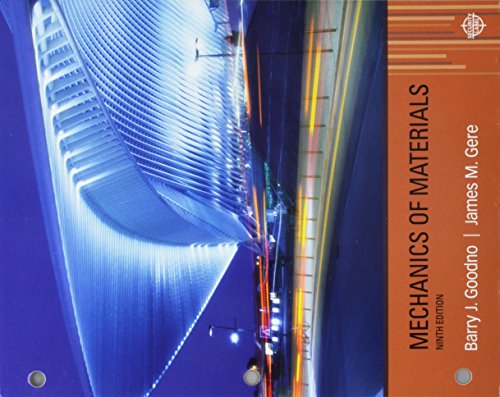
Concept explainers
Repeat Problem 8.5-22 but replace the square tube column with a circular tube having a wall thickness r = 5 mm and the same cross-sectional area (3900 mm2) as that of the square tube in figure b in Problem 8.5-22. Also, add force P. = 120 N at B
(a) Find the state of plane stress at C. (b) Find maximum normal stresses and show them on a sketch of a properly oriented element.
(c) Find maximum shear stresses and show them on a sketch of a properly oriented element.
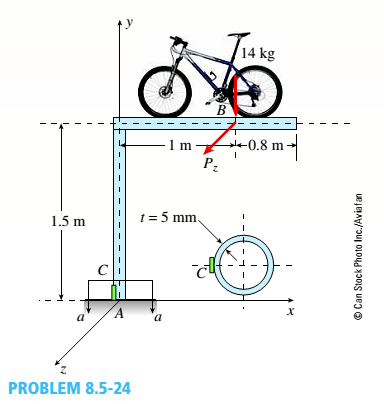
(a)
The state of plane stress on an element C.
Answer to Problem 8.5.24P
The state of stress on element C are
Tensile stress
Compressive stress
Explanation of Solution
Given information:
The cross-section of the bicycle rack tubing is circular.
The weight of the bicycle = 14 kg is represented as point load applied at B on a plane frame model of the rack.
A force in z direction has also been added Pz= 120 N
Weight density of the steel
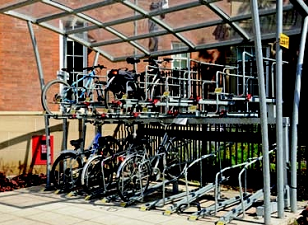
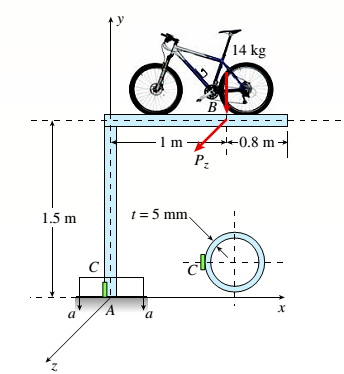
Calculation:
From the figure, let us consider horizontal portion of the cycle rack. The weight of the cycle is considered as the point load and this load produces a moment and a direct compressive load in the beam along Y-direction.
Also, a load Pzhas been added in z direction. This load will produce bending moment in the horizontal beam and twisting moment in the vertical portion of the beam.
The cross-sectional area of the beam is given by
The moment in the vertical beam =
The moment in the horizontal beam due to load Pz=
Total moment
The load Pzwill produce twisting moment equal to Mz. This twisting moment will produce the shear stress at the base of rack.
The direct compressive loading =
From the properties of the cross-section, the moment of inertia is
Now, plane stress can be calculated as follows
And maximum compressive stress is
Conclusion: Thus, the state of stress on element C are
Tensile stress
Compressive stress
(b)
The maximum normal stress and the sketch of properly oriented element.
Answer to Problem 8.5.24P
The normal stress values on element C are,
Explanation of Solution
Given information:
The cross-section of the bicycle rack tubing is circular.
The weight of the bicycle = 14 kg is represented as point load applied at B on a plane frame model of the rack.
A force in z direction has also been added Pz= 120 N
Weight density of the steel
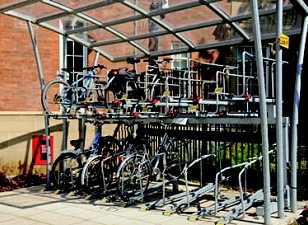

Calculation:
From the figure, let us consider horizontal portion of the cycle rack. The weight of the cycle is considered as the point load and this load produces a moment and a direct compressive load in the beam along Y-direction.
Also, a load Pzhas been added in z direction. This load will produce bending moment in the horizontal beam and twisting moment in the vertical portion of the beam.
The cross-sectional area of the beam is given by
The moment in the vertical beam =
The moment in the horizontal beam due to load Pz=
Total moment
The load Pzwill produce twisting moment equal to Mz. This twisting moment will produce the shear stress at the base of rack.
The direct compressive loading =
From the properties of the cross-section, the moment of inertia is
Now, plane stress can be calculated as follows
And maximum compressive stress is
The shear stress on the element is given by the torque and shear stress relation.
The normal stresses are given by
And,
The state of stress on the element can be shown as follows
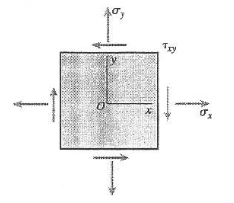
Conclusion: Thus, the normal stress values on element C are,
(c)
The maximum shear stress and the sketch of properly oriented element.
Answer to Problem 8.5.24P
the maximum stress values on element C is
Explanation of Solution
Given information:
The cross-section of the bicycle rack tubing is circular.
The weight of the bicycle = 14 kg is represented as point load applied at B on a plane frame model of the rack.
A force in z direction has also been added Pz= 120 N
Weight density of the steel
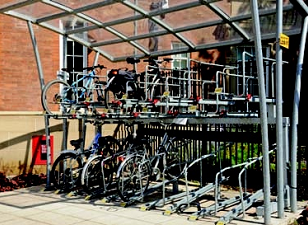
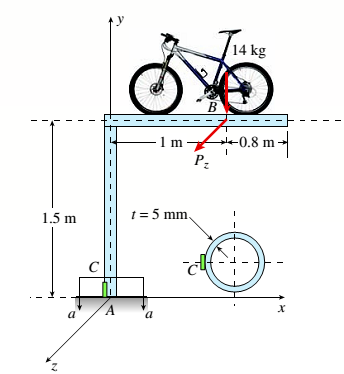
Calculation:
From the figure, let us consider horizontal portion of the cycle rack. The weight of the cycle is considered as the point load and this load produces a moment and a direct compressive load in the beam along Y-direction.
Also, a load Pzhas been added in z direction. This load will produce bending moment in the horizontal beam and twisting moment in the vertical portion of the beam.
The cross-sectional area of the beam is given by
The moment in the vertical beam =
The moment in the horizontal beam due to load Pz=
Total moment
The load Pzwill produce twisting moment equal to Mz. This twisting moment will produce the shear stress at the base of rack.
The direct compressive loading =
From the properties of the cross-section, the moment of inertia is
Now, plane stress can be calculated as follows
And maximum compressive stress is
The shear stress on the element is given by the torque and shear stress relation.
The normal stresses are given by
And,
The in plane maximum shear stress value is given by
The state of stress on the element can be shown as follows

Conclusion: Thus, the maximum stress values on element C is
Want to see more full solutions like this?
Chapter 8 Solutions
Bundle: Mechanics Of Materials, Loose-leaf Version, 9th + Mindtap Engineering, 1 Term (6 Months) Printed Access Card
- The stresses acting on element B on the web of a train rail (see figure part a of Problem 7.2-5) arc found to be 5700 psi in compression in the horizontal direction and 2300 psi in compression in the vertical direction (see figure). Also, shear stresses of magnitude 2500 psi act in the directions shown. Determine the stresses acting on an element oriented at a counterclockwise angle of 50° from the horizontal. Show these stresses on a sketch of an element oriented at this angle.arrow_forwardSolve the preceding problem if the stresses acting on element A on the web of a train rail (see figure part a of Problem 7.2-5) are found to be 40 MPa in tension in the horizontal direction and 160 MPa in compression in the vertical direction. Also. shear stresses of magnitude 54 MPa act in the direct ions shown in the figure. Determine the stresses acting on an element oriented at a counterclockwise angle of 520 from the horizontal. Show these stresses on a sketch of an element oriented at this angle.arrow_forwardAn element in plane stress is subjected to stresses ??x= 5750 psi, sy = 1100 psi, and txy= 750 psi (see the figure for Problem 7.3-1). Determine the principal stresses and show them on a sketch of a properly oriented element.arrow_forward
- A circle of a diameter d = 200 mm is etched on a brass plate (see figure). The plate has dimensions of 400 x 400 x 20 mm. Forces are applied to the plate, producing uniformly distributed normal stressescr^ =59 MPaander^ = —17 MPa. Calculate the following quantities: (a) the change in length Aac of diameter at: (b) the change in length Abd of diameter bd; (c) the change At in the thickness of the plate; (d) the change AV in the volume of the plate; (e) the strain energy U stored in the plate; (f) the maximum permissible thickness of the plate when strain energy £/must be at least 784 J; and (g) the maximum permissible value of normal stress axwhen the change in volume of the plate cannot exceed 0.015% of the original volume. (Assume E = 100 GPa and v = 0.34arrow_forward-4. - An element in plane stress is subjected to stresses ??x= 105 MPa, ??y= 75 MPa, and sxy= 25 MPa (see the figure for Problem 7.3-1). Determine the principal stresses and show them on a sketch of a properly oriented element.arrow_forwardThe normal and shear stresses acting on element B are ??x= -46 MPa, sy= -13 MPa, and txy= 21 MPa (see figure for Problem 7.2-10). Determine the maximum shear stresses and associated normal stresses and show them on a sketch of a properly oriented element.arrow_forward
- -11 A solid steel bar (G = 11.8 X 106 psi ) of diameter d = 2,0 in. is subjected to torques T = 8.0 kip-in. acting in the directions shown in the figure. Determine the maximum shear, tensile, and compressive stresses in the bar and show these stresses on sketches of properly oriented stress elements. Determine the corresponding maximum strains (shear, tensile, and compressive) in the bar and show these strains on sketches of the deformed elements.arrow_forwardA simply supported wood beam is subjected to point load P at mid-span. The stresses on element C are known to be ??x=-92 psi and txy= -7 psi. Find the principal stresses on the element and show them on a sketch of a properly oriented clement.arrow_forward-9The stresses acting on element B in the web of a wide-flange beam are found to be 14,000 psi compression in the horizontal direction and 2600 psi compression in the vertical direction. Also, shear stresses of magnitude 3800 psi act in the direct ions shown (see the figure for Problem 7.2-9). Determine the maximum shear stresses and associated normal stresses and show them on a sketch of a properly oriented element.arrow_forward
- An element in plane stress from the fuselage of an airplane is subjected to compressive stresses of magnitude 35 MPa in the horizontal direction and tensile stresses of magnitude 6.5 MPa in the vertical direct ion. Also, shear stresses of magnitude 12.5 MPa act in the directions shown (see the figure for Problem 7.2-8). Determine the maximum shear stresses and associated normal stresses and show them on a sketch of a properly oriented element.arrow_forwardAn element on the gusset plate in Problem 7.2-23 in uniuxial stress is subjected to compressive stresses of magnitude 6750 psi. as shown in the figure. Using Mohr’s circle, determine the following. (a) The stresses acting on an element oriented at a slope of 1 on 2 (see figure). (b) The maximum shear stresses and associated normal stresses. Show all results on sketches of properly oriented elements. sarrow_forwardActing on the sides of a stress element cut from a bar in uniaxial stress are tensile stresses of 10,000 psi and 5000 psi, as shown in the figure. (a) Determine the angle 0 and the shear stress T and show all stresses on a sketch of the element. (b) Determine the maximum normal stress amaxand the maximum shear stress Tmax in the material.arrow_forward
 Mechanics of Materials (MindTap Course List)Mechanical EngineeringISBN:9781337093347Author:Barry J. Goodno, James M. GerePublisher:Cengage Learning
Mechanics of Materials (MindTap Course List)Mechanical EngineeringISBN:9781337093347Author:Barry J. Goodno, James M. GerePublisher:Cengage Learning
